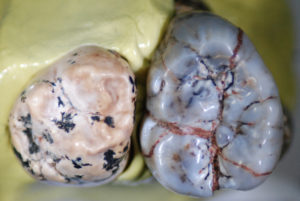
Science Advances, AAAS—Using calcium isotopes present in the enamel of fossilized teeth as a proxy for breast milk intake, scientists report* that early Homo infants nursed longer and their mothers experienced greater intervals between births compared to other South African hominins. The authors say their method offers a potential way to further explore the weaning behaviors during the evolution of hominid and mammals more broadly. Hominin nursing behavior has proven difficult to study, with researchers relying on deductions about body size and dental development from fossil records. However, observations that low calcium isotopes in modern human breastmilk are mirrored in infant enamel composition suggest scientists can turn to high resolution analysis of isotopes in ancient teeth for answers. Here, Théo Tacail et al. measured calcium isotope in teeth from 12 Australopithecus africanus, 18 Paranthropus robustus and seven early Homo specimens. They also analyzed teeth of mammals that coexisted with the hominins, including seven browsers, seven carnivores and 10 grazers, as well as four modern gorilla teeth for comparison. Tacail and colleagues found no clear relationship between calcium isotope value and dental age in A. africanus and only a slight correlation in P. robustus. In contrast, they found that calcium isotope levels in early Homo infants increased substantially with dental age, suggesting early Homo infants relied on milk from their mothers while infants from the other two hominin species consumed solid adult food and some breast milk. The researchers caution that it is difficult to draw conclusions about A. africanus and P. robustus, because the calcium isotope values in their breast milk are unknown.
______________________________

Tooth morphology is obviously distinctive between early Homo (right) and Paranthropus robustus (left) but differences also exist in the calcium stable isotope compositions that reveal specific nursing behaviors. Vincent Balter, CNRS
______________________________
Article Source: Science Advances – A publication of the American Association for the Advancement of Science.
*“Calcium isotopic patterns in enamel reflect different nursing behaviors among South African early hominins ,” by T. Tacail; J.E. Martin; F. Arnaud-Godet; V. Balter at CNRS in Lyon, France; T. Tacail; J.E. Martin; F. Arnaud-Godet; V. Balter at LGLTPE in Lyon, France; T. Tacail; J.E. Martin; F. Arnaud-Godet; V. Balter at Univ. Lyon in Lyon, France; T. Tacail at University of Bristol in Bristol, UK; J.F. Thackeray; J. Braga at University of the Witwatersrand in Johannesburg, South Africa; T.E. Cerling at University of Utah in Salt Lake, UT; J. Braga at CNRS in Toulouse, France; J. Braga at Paul Sabatier University in Toulouse, France.
________________________
See, first-hand, the original fossils. See original artifacts. See the actual sites. Talk with the famous scientists. Join us on this unique specialized study tour.





